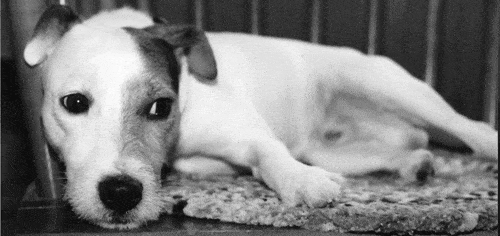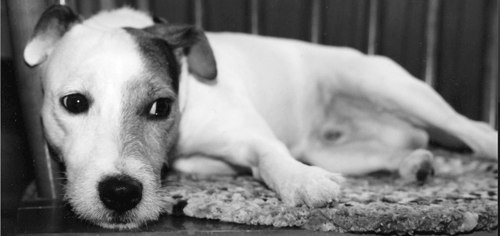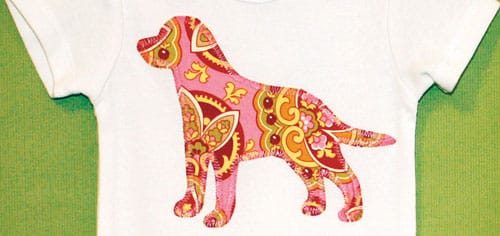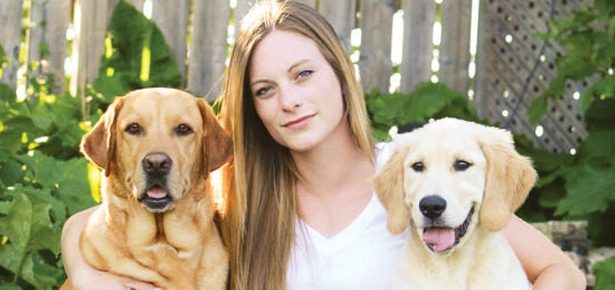

Mutts Doing Math: Not So Far-Fetched?
1+1=?
PATTIE WAS ABOUT EIGHT YEARS OLD, WITH HAIR THE SAME COLOUR as that of the Golden Retriever sitting in front of her. She was demonstrating to me how she had taught her dog, Emma, to speak.
With a treat held high over the dog’s face she carefully enunciated: “Hello.” The dog responded with “Ar-ouw” and the girl giggled with pleasure.
Next she carefully said, “I love you, Emma,” and the dog answered, “Ar-ouw-ouw-ouw-ouw,” and was awarded a treat and a happy hug.
While I doubt that any linguist would credit these utterances from the dog as demonstrating language, they are remarkable because they do demonstrate mathematical ability. Little Pattie was carefully making each syllable distinct, and the dog seemed to be counting the sounds. Thus when Pattie said two syllables (“Hello”), the dog made two separate sounds and when the girl uttered five syllables, the dog made five distinct sounds.
Some people dismiss the idea that dogs can do the most rudimentary type of quantitative reasoning, such as determining which of two plates contains more kibble. Early researchers claimed that dogs couldn’t discriminate between a plate with three and another with eight kibbles. The studies demonstrating this, however, were flawed, since the dogs’ strategy turned out to be simply “Grab the food from the closest plate.” More careful studies have used pairs of panels, each of which had dots painted on it. Dogs were trained to always press the panel with the largest (or smallest) number of dots. The training was slow but the dogs did learn this task.
However the Golden Retriever, Emma, seemed to be doing something more sophisticated than this. She seemed to be actually counting. This ability turns out to be common in some breeds of dogs. It was first demonstrated to me after a dog obedience competition on Vancouver Island. I had completed my time in the ring and had taken my dog out of the building to enjoy the spring day. One of the other competitors had also finished for the day, and was out on a large nearby field with his small black Labrador Retriever, Poco. He had a box of orange plastic retrieving bumpers with him and told me that he would use these to demonstrate that his dog could count.
“She can count to four quite reliably, and to five with only an occasional miss,” he said. “I’ll show you how it works. First you pick a number from one to five.”
I picked the number three. While the dog watched, he then tossed three lures out into the field. The bumpers were tossed in different directions and at different distances and disappeared from sight in the high grass. To be sure that they were not visible, I got down on my hands and knees at the dog’s eye level to verify that the bumpers couldn’t be seen from the starting position. Then, without pointing or giving any other signals, the man simply told the dog, “Poco, fetch.” Obediently she went out to the most recently thrown bumper and brought it back. He took the bumper from the dog and repeated, “Poco, fetch.”
Immediately Poco started to cast about and search for the next one. After the second bumper was returned, he repeated the command and the dog went out after the remaining lure. Removing this third one from the dog’s mouth, the man continued as if he believed that there was yet another object out there to be retrieved, again giving the command “Poco, fetch.” At this, the dog simply looked at him, barked once, and moved to his left side, to the usual heeling position, and sat down.
He gave Poco a pat and murmered, “Clever girl,” then turned to me and said, “She knows that she’s retrieved all three, and that’s all there were. She keeps a running count. When there are no more bumpers to find, she lets me know with that ‘They’re all here, stupid’ bark that you just heard, and then goes to heel to let me know that she’s ready for the next thing that I want her to do.”
I was impressed, but still a bit skeptical. So we spent the better part of a half hour repeating the test, varying the number of bumpers up to five, with me and another dog handler tossing the bumpers and sending the dog to fetch as sort of a check to see if anything in the way the items were placed or the commands were given made a difference. None of these changes seemed to matter; even with five objects, the dog never missed the count once. If I had conducted a similar experiment with my young grandchildren by tossing toys behind items of furniture, and they had performed as well as Poco, I certainly would have taken that as proof that they could count from one to five!
If we accept the fact that dogs can count, how about the possibility that they can do simple arithmetic? I am not suggesting that dogs can multiply 333 by 501 and then divide the result by 17 and present us with an answer, but how about something simple, like demonstrating that they understand that 1+1=2? Two researchers, Robert Young of the Pontifical Catholic University in Brazil and Rebecca West of the University of Lincoln in the U.K., attempted to test this idea using a group of 11 mixed-breed dogs and a set of tempting dog treats.
These researchers modified a test that has been used to prove that human infants at the age of five months possess a rudimentary ability to count. The technique involves something called “preferential viewing,” which simply measures the amount of time that infants spend looking at things. It has been shown that infants (just like adults) will stare at something unexpected or unusual for a longer time. The human test for counting is quite simple. First the child is a shown a small doll on a table and then a low screen is put in front of it to block the child’s view. The experimenter takes another doll, shows it to the child, and then puts it behind the screen. If the child can count, he or she should expect that when the screen is raised there will be two dolls, and sometimes that is the case.
However sometimes the experimenter secretly removes one of the dolls so that now when the screen is raised there is only one doll visible. When this occurs, the babies stare at what is on the table for much longer after the screen has been raised, suggesting that they have made the calculation and worked out that the number of dolls that they are seeing is different than what they expected it to be. In the canine version of this test, Young and West first showed the dog a single large treat. Then a low screen was lowered and the dog watched as the experimenter obviously placed another treat down behind the screen and out of his view. In the normal situation, where 1+1=2, the dog should expect that when the screen was raised there should be two dog treats visible. However, just as when testing babies, sometimes the experimenters cheated and surreptitiously removed one of the treats, so that when the screen was raised the dog saw only one treat remaining. In effect he was faced with an equation that said 1+1=1. Much like the babies, the dogs stared at this unexpected outcome for longer periods than they did when the arithmetic came out correctly, apparently “surprised” at finding only one object.
Now, before granting that dogs can count based on this finding, we must consider the possibility that they simply know that one object plus another object should equal more than one object, but not specifically two objects. To check for this possibility the experimenters also presented the dogs with the result 1+1=3 by secretly slipping another treat behind the screen so that when it was raised they saw three objects rather than expected two. The dogs appeared to be equally surprised by this outcome, and spent just as long staring at this odd result as they did when the outcome was smaller than they might have predicted. This suggests that the dogs expected that 1+1= 2, and no other answer was correct. If this is true, then dogs can not only count, but can also do simple addition and subtraction.
Simple counting and arithmetic ability might seem to be a superfluous ability for dogs, but it is a useful skill that would have been valuable to dogs’ wild ancestors.
According to Dr. Young, “Wolves live in sophisticated social groups where knowing the number of allies and the number of enemies you have in a group would be very important in determining whether a behavioural strategy, for example trying to take over the group, would be successful or not.”
For a breeding female wolf, this same numerical skill would allow her to know if her entire litter of wolf cubs was present, or if one of them had somehow gone astray, necessitating a search.
This opens up a whole new vista for service dogs. Perhaps we now have a solution for the financial scandals that have rocked business and government recently. These have been blamed on shoddy or dishonest accounting practices. Remember, dogs are honest, loyal and protective of their own property. They also provide unconditional love to their owners; there is no reason to expect that they wouldn’t do the same for their employers. They also would be a great savings to any company because they would work for practically nothing. So perhaps we should think about training a new class of CPAs—“Canine Public Accountants.”
Comments (1)
Join the newsletter and never miss out on dog content again!
"*" indicates required fields
By clicking the arrow, you agree to our web Terms of Use and Privacy & Cookie Policy. Easy unsubscribe links are provided in every email.





